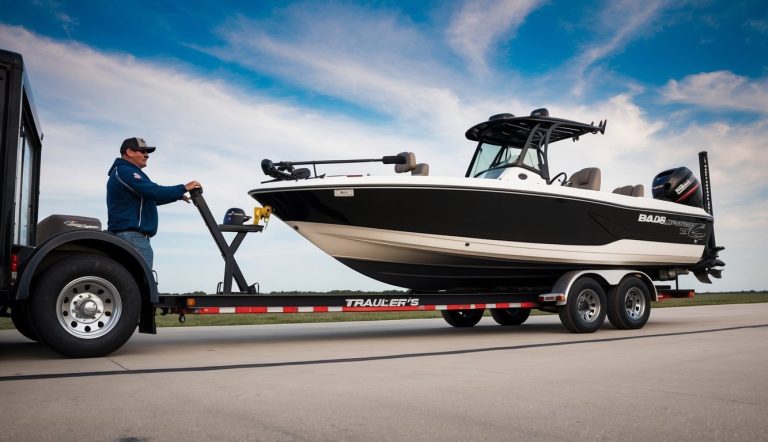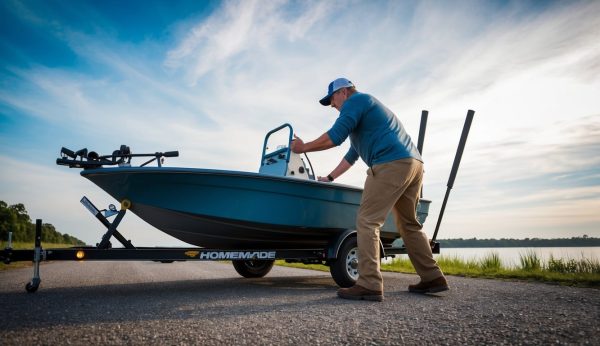Understanding Bass Boat Transportation
When moving your bass boat, you have two main options: using a trailer or hiring a professional hauler. Each method has distinct advantages based on your needs, budget, and the distance your boat needs to travel.
Bass Boat Trailers Overview
Bass boat trailers are specially designed to transport these fishing vessels safely on the road. Most bass boat owners use trailers designed specifically for bass boats, which provide the right support and fit for your vessel’s hull.
A quality bass boat trailer offers several advantages:
- Direct access to your boat whenever you need it
- Cost-effective for frequent short-distance trips
- Control over your transportation schedule
For maximum stability, many owners prefer a tandem-axle trailer. These trailers have two axles with four wheels, which provide better weight distribution and steadier towing compared to single-axle models. Your trailer must be properly rated for your boat’s weight. A properly fitted trailer prevents damage during transport and ensures safer towing on highways.
Professional Hauler Services Explained
Professional boat transportation services offer a convenient alternative when you can’t or don’t want to transport your bass boat yourself. Professional haulers typically use either flatbed trucks or specialized boat trailers. Many boat manufacturers transport new vessels using flatbed trucks, similar to car haulers. These professionals handle all aspects of securing and moving your boat.
Benefits of using professional haulers include:
- Reduced wear on your vehicle
- Insurance coverage during transport
- Experience in securing boats properly
- Long-distance capability without you driving
The cost difference between flatbed and trailer transport can be significant. According to one boat owner, flatbed service was $1,350 more expensive than trailer transport for the same journey. While typically more expensive than DIY transport, professional services provide peace of mind, especially for long distances.
Types of Bass Boat Trailers

Bass boat trailers come in different configurations to match your boat size, weight, and towing needs. Your choice will affect how your boat handles on the road and impacts long-term maintenance costs.
Single-Axle Trailers
- Single-axle trailers feature one axle with two wheels, making them lightweight and easy to maneuver. These trailers are ideal for smaller bass boats under 18 feet and lighter loads.
- The simpler design means fewer mechanical parts to maintain and lower initial costs. You’ll find them easier to navigate in tight spaces like your garage or driveway.
- Single-axle trailers also offer less rolling resistance, which can improve your fuel economy when towing. However, they provide less stability on highways and during emergency maneuvers.
- One significant drawback is that a flat tire means immediate roadside assistance, as you cannot continue driving safely. They also offer less weight distribution, potentially causing more wear on your vehicle’s suspension system.
Tandem-Axle Trailers
- Tandem-axle trailers feature two axles with four wheels, providing superior stability and weight distribution. These trailers are recommended for larger bass boats over 18 feet or heavier models.
- Tandem trailers offer better control and safety on the road, especially at highway speeds or in windy conditions. If you experience a flat tire, you can still drive a short distance to find help.
- The weight distribution across four wheels reduces stress on each tire and your towing vehicle. This makes tandem trailers ideal for long-distance travel to fishing tournaments or vacation spots.
- The main disadvantages include higher initial cost, increased weight, more maintenance requirements, and more difficulty maneuvering in tight spaces. You’ll also face greater rolling resistance, slightly reducing fuel efficiency.
Trailer Frame Materials
- Trailer frames are typically constructed from steel, aluminum, or galvanized steel, each offering different benefits for bass boat owners.
- Steel frames provide excellent strength and durability at a lower cost. They can handle heavier loads and rough terrain but are susceptible to rust unless properly maintained. Most steel frames use square or rectangular tubing for structural integrity.
- Aluminum frames weigh significantly less than steel, improving your fuel economy and making the trailer easier to tow. They naturally resist corrosion, making them ideal if you fish in saltwater environments. The trade-off is higher initial cost and slightly less durability for extremely heavy loads.
- Galvanized steel frames combine steel’s strength with corrosion resistance. The zinc coating protects against rust, extending the trailer’s lifespan. This option sits between steel and aluminum in terms of price and offers excellent value for most bass boat owners.
- Regular inspection of frame welds and tubing connections is essential regardless of material choice.
Key Features of Bass Boat Trailers
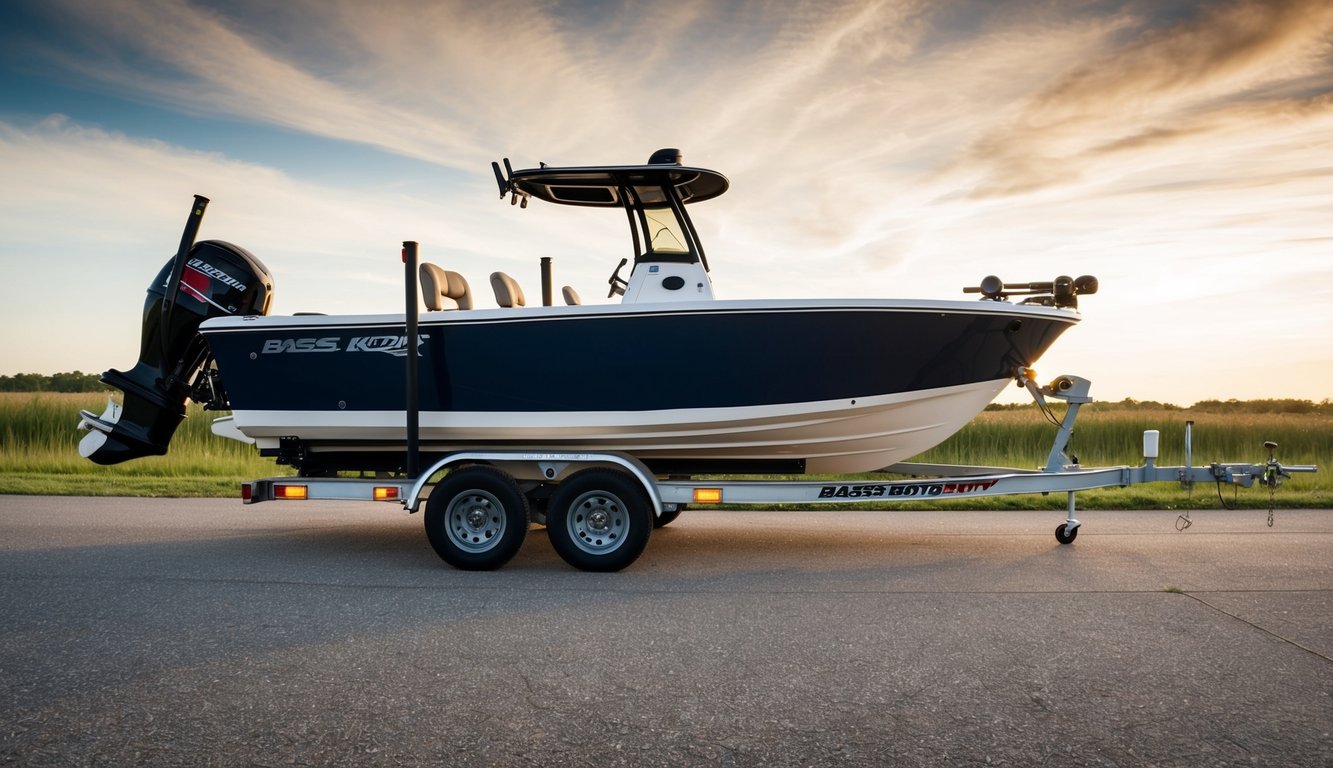
Bass boat trailers come with specialized features designed for safely transporting your valuable watercraft. These components work together to protect your boat during transport and make launching and loading easier.
Bunks and Rollers
- Trailer bunks provide critical support for your boat’s hull. Most bass boat trailers feature carpeted wooden bunks that distribute the boat’s weight evenly. These bunks prevent hull damage by cushioning the boat during transport.
- Some trailers use a combination of bunks and rollers for easier loading. Rollers help guide your boat onto the trailer when loading, reducing friction and making the process smoother. They’re positioned strategically at the rear and sometimes along the sides of the trailer.
- Full roller trailers exist but are less common for bass boats because they can create pressure points on the hull. The ideal setup for most bass boats includes carpeted bunks for support with a few rollers at key positions to aid loading.
- When choosing between bunks and rollers, consider your typical launching conditions. For shallow ramps, rollers offer advantages. For deeper launches, full bunks provide better support.
Winches and Strapping
A quality winch is essential for securing your bass boat to the trailer. Manual winches are common and reliable, while electric winches offer convenience but at a higher cost. Your winch should have sufficient capacity for your boat’s weight.
The winch strap or cable connects to your boat’s bow eye and should be regularly inspected for wear. Most bass boat trailers include a safety chain as a backup to the winch strap – always use both for maximum security. Proper tie-down straps are equally important. You’ll need transom straps to secure the stern and possibly additional straps for the hull. These prevent the boat from shifting during transport.
When selecting strapping equipment, look for:
- Weather-resistant materials
- Adequate load ratings
- Secure, non-marring buckles
- Easy adjustability
Never skimp on quality with winches and straps. They’re your primary defense against trailer accidents.
Tubing and Support
- Bass boat trailers typically feature either aluminum or steel construction. Aluminum trailers resist corrosion, are lighter weight, and can improve gas mileage. Steel trailers offer greater strength but require more maintenance to prevent rust.
- The frame design matters significantly. Look for sufficient cross-members to support your boat’s weight. Tandem axle designs provide better stability and safer handling, especially for larger bass boats. They maintain better control even if you experience a tire failure.
- Proper support also includes quality suspension. Leaf springs or torsion axles cushion your boat against road vibrations. Torsion axles typically provide a smoother ride but at a higher cost.
- Don’t overlook the importance of fenders and guides. Fenders protect against road spray while guides help align your boat during loading. Many premium trailers include LED lighting systems that enhance visibility and last longer than traditional bulbs.
Comparing Transportation Methods for Performance
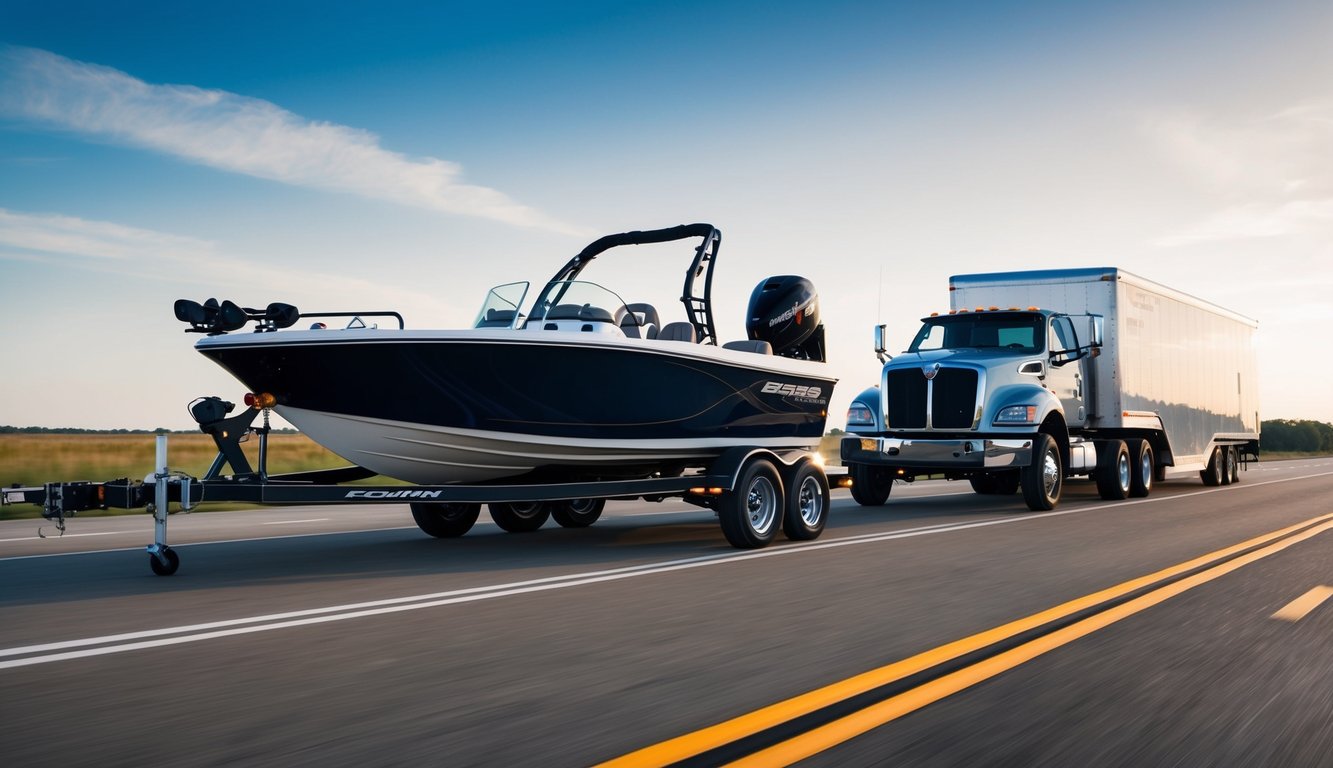
When deciding between trailering your bass boat yourself or hiring a professional hauler, performance aspects significantly impact your experience. Each transportation method offers distinct advantages in how quickly you can get to your destination, how well the boat handles during transit, and long-term effects on your vessel.
Speed and Efficiency
- Trailering your own bass boat typically allows for more flexibility in departure times and route planning. You can leave when you want and take breaks as needed. However, you’re limited by standard highway speed limits—usually 55-65 mph with a trailer.
- Professional boat haulers often follow strict schedules that may include overnight driving. They can sometimes achieve faster overall transit times for long distances because they rotate drivers and maintain consistent progress.
- Your personal schedule matters too. If you need your boat transported while you’re working, a hauler provides efficiency you can’t match personally.
Handling and Maneuverability
- Self-trailering gives you complete control over how your boat is handled. You decide the speed over bumps and around corners, potentially providing gentler transportation.
- Tandem trailers offer better tracking and reduced fishtailing, making them safer for longer journeys. This stability is crucial when carrying something as valuable as a bass boat.
- Professional haulers typically use specialized equipment designed specifically for boat transport. Their experience navigating challenging roads and backing into tight spaces often exceeds that of occasional towers.
- Weather conditions affect handling too. Professionals are trained to navigate difficult conditions, while you might need to delay your trip during bad weather.
Longevity and Maintenance
- Regular trailering puts wear on both your towing vehicle and the trailer. Your truck’s transmission, brakes, and engine all experience additional strain during towing.
- Commercial boat transport removes this wear from your personal vehicle but introduces potential for damage during loading and unloading by others. However, professional haulers are typically insured against such damages.
- Trailer maintenance becomes your responsibility with self-transport. You’ll need to regularly check bearings, lights, tires, and brakes to ensure safe operation.
- Some insurance policies may have exclusions for boats being transported by commercial haulers. Always verify coverage before choosing a transport method to protect your investment.
Evaluating Stability and Safety
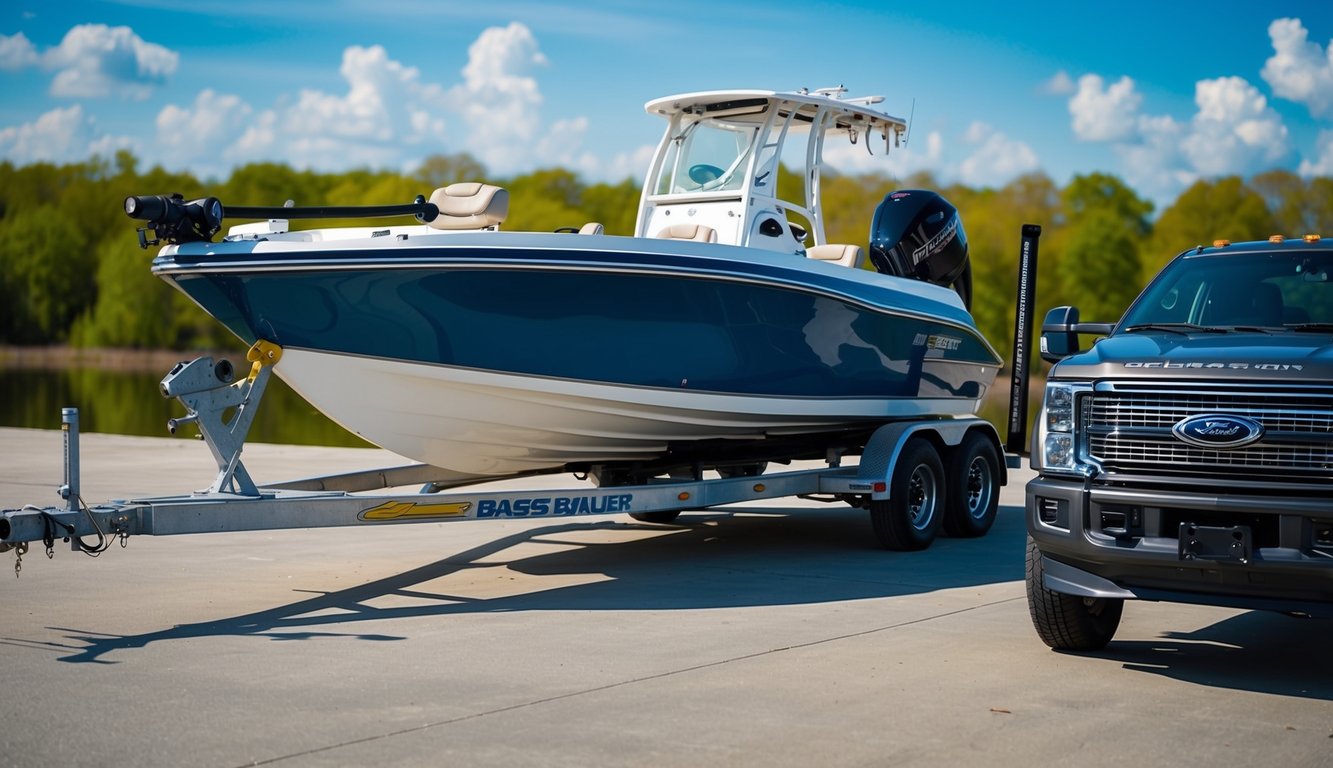
When transporting your bass boat, stability and safety should be your top priorities to prevent accidents and damage to your vessel. The right transportation choice can make all the difference in ensuring your boat arrives safely.
Stability on the Road
- Trailer stability varies significantly based on design and axle configuration. Tandem axle trailers provide better weight distribution and improved stability at higher speeds compared to single axle options. This is crucial when hauling larger bass boats over long distances.
- Professional haulers use specialized equipment designed specifically for boat transport. Their trailers often feature advanced suspension systems that absorb road vibrations better than standard trailers.
- Weather conditions can dramatically affect stability. Strong crosswinds pose less risk with professional haulers whose rigs are designed to handle such challenges. Their trailers typically sit lower to the ground, creating a lower center of gravity.
- For DIY transport, you should consider your vehicle’s towing capacity carefully. An undersized tow vehicle compromises stability even with the best trailer.
Safe Loading and Unloading Practices
- Different trailer types require different loading techniques. Bunk trailers provide more stability than roller trailers but demand more effort during loading and unloading.
- Professional haulers employ standardized loading procedures with specialized equipment like hydraulic lifts and winches that minimize risks. Their expertise in securing boats properly prevents shifting during transport.
- Powerboats require specific trailer configurations due to their unique weight distribution. Professionals understand these requirements and have the right equipment.
- You should always use proper tie-downs and transom straps regardless of your transport method. For DIY hauling, invest in quality straps and learn proper securing techniques to prevent movement during transit.
- Ramp conditions can affect safe loading. Professional services can often handle challenging launch sites better than the average boat owner with standard equipment.
